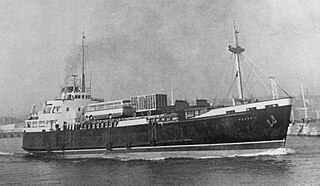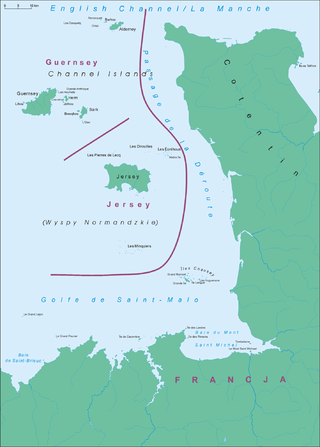Related Research Articles

The Channel Islands are an archipelago in the English Channel, off the French coast of Normandy. They are divided into two Crown Dependencies: the Bailiwick of Jersey, which is the largest of the islands; and the Bailiwick of Guernsey, consisting of Guernsey, Alderney, Sark, Herm and some smaller islands. Historically, they are the remnants of the Duchy of Normandy. Although they are not part of the United Kingdom, the UK is currently responsible for the defence and international relations of the islands. The Crown Dependencies are neither members of the Commonwealth of Nations, nor part of the European Union. They have a total population of about 171,916, and the bailiwicks' capitals, Saint Helier and Saint Peter Port, have populations of 33,500 and 18,207 respectively.

Royal Mail Ship, usually seen in its abbreviated form RMS, is the ship prefix used for seagoing vessels that carry mail under contract to the British Royal Mail. The designation dates back to 1840. Any vessel designated as "RMS" has the right both to fly the pennant of the Royal Mail when sailing and to include the Royal Mail "crown" insignia with any identifying device and/or design for the ship.
Nine ships of the Royal Navy and one of the Royal Fleet Auxiliary have been named Argus, after Argus, the hundred-eyed giant of mythology:

The Union-Castle Line was a British shipping line that operated a fleet of passenger liners and cargo ships between Europe and Africa from 1900 to 1977. It was formed from the merger of the Union Line and Castle Shipping Line.
Several ships have been named Innisfallen, the name being derived from the island of Innisfallen in County Kerry and often given to vessels serving the southerly coasts of Ireland. Five served on the Irish Sea route between Cork and Fishguard, from 1896 onwards: two of these were war casualties whilst the remainder have been either scrapped or renamed and sold to new owners.

The Royal Mail Steam Packet Company was a British shipping company founded in London in 1839 by a Scot, James MacQueen. The line's motto was Per Mare Ubique. After a troubled start, it became the largest shipping group in the world in 1927 when it took over the White Star Line. The company was liquidated and its assets taken over by the newly formed Royal Mail Lines in 1932 after financial trouble and scandal; over the years RML declined to no more than the name of a service run by former rival Hamburg Süd.

RMS Empress of India was an ocean liner built in 1890-1891 by Naval Construction & Armaments Co, Barrow-in-Furness, England for Canadian Pacific Steamships. This ship would be the first of two CP vessels to be named Empress of India, and on 28 April 1891, she was the very first of many ships named Empress arriving at Vancouver harbor.

MS Arrow is a 7,606 GT Ro-Ro ferry built by Astilleros de Huelva SA, Huelva, Spain in 1998 as Varbola for the Estonian Shipping Company, Tallinn. During a charter to Dart Line she was renamed Dart 6, reverting to Varbola when the charter ended. In 2005, she was sold to Malta and renamed RR Arrow. In 2007, she was sold to Seatruck Ferries, Heysham and renamed Arrow. In September 2022, it was revealed that she had been bought by Isle of Man Steam Packet Company for an estimated €9 million.
Arpha was a 602 GRT passenger ferry built in 1900 as Canterbury for the South Eastern and Chatham Railway. She passed to the Southern Railway on 1 January 1923. She was sold to W E Guinness in 1926 and renamed Arpha. In 1938 she was sold to Sark Motorships Ltd, only to be requisitioned by the Royal Navy in 1939. Postwar, she was sold to Compania Shell de Venezuela and renamed Coriano. After a further change of ownership she was scrapped in 1955.
HMS Argus was a steamship that was built in Scotland in 1904 as a cutter and fishery protection ship for the His Majesty's Coast Guard, and later served in the Royal Navy as HMS Argon. After the First World War she was converted into a passenger ferry, serving first the Isles of Scilly as Peninnis and then in the Channel Islands as Riduna. She was scrapped in England in 1932.
The St. Malo & Binic Steamship Company operated shipping services to and from the Channel Islands from 1897 to 1938.

TSS (RMS) Mona’s Queen (IV) was a passenger vessel operated by the Isle of Man Steam Packet Company from 1946 to 1962. Sold to the Chandris group in 1962, she was adapted for cruising and operated as Carina and, from 1964 Fiesta until scrapped in Greece in 1981.

MV Peveril was a coastal cargo vessel operated by the Isle of Man Steam Packet Company. Peveril, the third ship in the Company's history to bear the name, was built by Ailsa Shipbuilding Company at Troon, Scotland, in 1964.

SS (RMS) Mona (II) No. 76302 was a packet steamer operated by the Isle of Man Steam Packet Company. Mona was the first screw-driven ship in the company's history.

SS (RMS) Snaefell (I) – the first ship in the Company's history to bear the name – was an iron paddle steamer that served with the Isle of Man Steam Packet Company until she was sold in 1875.

MV Conister (II) No. 187114 was a cargo vessel operated by the Isle of Man Steam Packet Company, the second vessel in the Company's history to bear the name.

SS (RMS) Mona (III), the third ship of the Company to bear the name, was a steel paddle-steamer which was originally owned and operated by the London, Chatham and Dover Railway Company, who then sold her to the Liverpool and Douglas Steamship Company, from whose liquidators she was acquired by the Isle of Man Steam Packet Company in 1903.

The first postal service took place using mail sent with captains of packet ships, using agents in the England and in the islands for the end delivery. The cost was normally 3d. The first pillar boxes in Britain were introduced in the Channel Islands as an experiment in 1852, to collect mail for the Royal Mail packet boats. The oldest pillar box in use in the British Isles is in Guernsey.

The Channel Islands are a group of islands off the coast of France. The largest island is Jersey, followed by Guernsey, Alderney, Sark, and a number of smaller islands, islets and rocky outcrops. The islands were separated from mainland Europe with rising sea levels in the Neolithic period; thereafter maritime activity commenced.

Archaeology is promoted in Jersey by the Société Jersiaise and by Jersey Heritage. Promotion in the Bailiwick of Guernsey being undertaken by La Société Guernesiaise, Guernsey Museums, the Alderney Society with World War II work also undertaken by Festung Guernsey.
References
- ↑ Ships monthly, Volume 10. 1975
- ↑ UK Retail Price Index inflation figures are based on data from Clark, Gregory (2017). "The Annual RPI and Average Earnings for Britain, 1209 to Present (New Series)". MeasuringWorth. Retrieved 11 June 2022.
- ↑ Sea breezes: the ship lovers' digest, Volumes 13-14, Pacific Steam Navigation Company, C. Bichell, 1952
- ↑ Guernseythrough the lens, including Alderney, Sark, Herm and Jethou: photographs taken before 1914 Victor Coysh, Carel Toms, 1978
- ↑ "Archived copy". Archived from the original on 24 November 2018. Retrieved 22 November 2010.
{{cite web}}: CS1 maint: archived copy as title (link) - ↑ Coysh, Victor (1991). Maritime Alderney. Guernsey Press. ISBN 0902550438.
